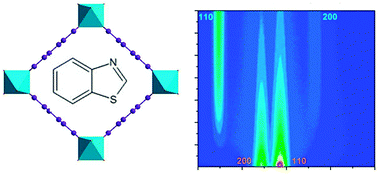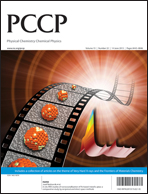The adsorption of N/S-containing heterocyclic organic molecules in the flexible iron(III) terephthalate MIL-53, FeIII(OH)0.6F0.4(O2C–C6H4–CO2)·(H2O), from the liquid phase was studied with in situ energy dispersive X-ray diffraction (EDXRD), in order to follow the adsorption-induced expansion of the structure. For comparison with the diffraction data, liquid phase adsorption isotherms were recorded for uptake of benzothiophene, benzothiazole and indole in isopropanol and in heptane. The solvent not only influences pore opening but is also a competing guest. The in situ EDXRD experiments allow the kinetics of guest uptake and the competition with solvent to be monitored directly. Indole uptake is limited; this adsorbate is barely capable of opening the closed, either hydrated or dehydrated, MIL-53(Fe) structure, or of penetrating the isopropanol-containing material in the concentration range under study. When isopropanol is used as a solvent, the guest molecules benzothiophene and benzothiazole must be present at a certain threshold concentration before substantial adsorption into the metal–organic framework takes place, eventually resulting in full opening of the structure. The fully expanded structures of benzothiophene or benzothiazole loaded MIL-53(Fe) materials have Imcm symmetry and a unit cell volume of ca. 1600 Å3, and upon uptake of the guest molecules by the closed form (unit cell volume ∼1000 Å3) no intermediate crystalline phases are seen. Successful uptake by MIL-53(Fe) requires that the adsorbate is primarily a good hydrogen bond acceptor; additionally, based on UV-visible spectroscopy, a charge-transfer interaction between the S atoms of benzothiophene and the aromatic rings in the MOF pore wall is proposed.

You have access to this article
 Please wait while we load your content...
Something went wrong. Try again?
Please wait while we load your content...
Something went wrong. Try again?


 Please wait while we load your content...
Please wait while we load your content...